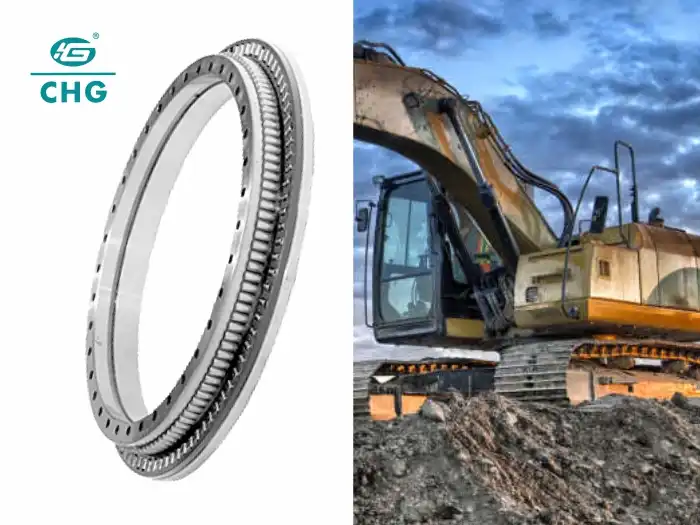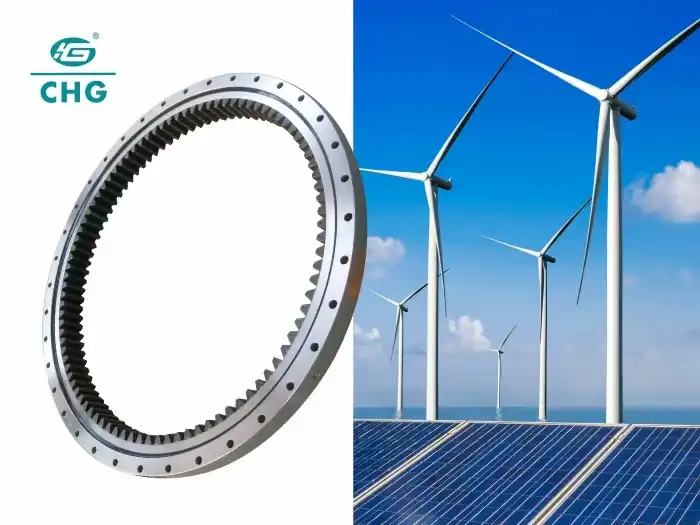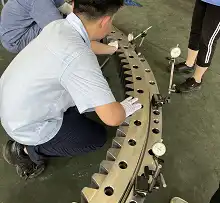Slewing Rings vs. Traditional Bearings: What’s the Difference?
In the world of mechanical engineering and industrial machinery, the choice between slewing rings and traditional bearings can significantly impact the performance, efficiency, and longevity of equipment. Slewing rings, also known as slewing bearings, are specialized components designed to handle complex load combinations while facilitating rotational movement. Unlike conventional bearings, slewing rings can simultaneously support axial, radial, and moment loads, making them indispensable in applications requiring both load-bearing capacity and rotational precision. This unique capability sets them apart from traditional bearings, which are typically designed to handle specific load types. The distinction becomes particularly crucial in large-scale machinery and equipment where the demands on bearing systems are multifaceted and intense. As we delve deeper into the comparison between slewing rings and traditional bearings, we'll explore their structural differences, load-bearing capabilities, and the diverse applications that highlight the advantages of each type.
What are the key advantages of slewing rings over traditional bearings?
Enhanced Load-Bearing Capacity
Slewing rings excel in their ability to handle complex load combinations, significantly outperforming traditional bearings in this aspect. Their design allows them to simultaneously support axial, radial, and moment loads, making them ideal for applications where multidirectional forces are at play. This enhanced load-bearing capacity is particularly evident in heavy machinery such as cranes, excavators, and wind turbines. Slewing rings can distribute loads more evenly across a larger surface area, reducing stress on individual components and extending the overall lifespan of the equipment. Moreover, their ability to handle moment loads effectively eliminates the need for additional support structures in many applications, leading to more compact and efficient machine designs. This advantage of slewing rings translates into improved operational stability, reduced maintenance requirements, and enhanced safety in high-stress environments.
Precision and Accuracy in Rotational Movement
When it comes to precision in rotational movement, slewing rings offer a significant advantage over traditional bearings. Their design incorporates features that ensure smooth, accurate rotation even under heavy loads. This precision is crucial in applications such as medical imaging equipment, radar systems, and telescopes, where even the slightest deviation can impact performance. Slewing rings achieve this high level of accuracy through their integrated gear systems and the use of high-precision rollers or balls. The gear systems in slewing rings allow for controlled, incremental movements, essential in positioning systems for large structures. Additionally, the larger diameter of slewing rings compared to traditional bearings provides a more stable rotational platform, reducing vibration and improving overall system stability. This enhanced precision not only improves the quality of output in various applications but also contributes to the longevity of the equipment by minimizing wear and stress on related components.
Versatility in Design and Application
The versatility of slewing rings sets them apart from traditional bearings in terms of design flexibility and application range. Slewing rings can be customized to meet specific requirements, including size, load capacity, and gear configurations. This adaptability makes them suitable for a wide array of industries, from construction and mining to renewable energy and aerospace. For instance, in wind turbines, slewing rings enable the precise positioning of blades and nacelles, optimizing energy capture. In construction equipment, they allow for the smooth rotation of excavator cabins and crane booms. The design of slewing rings can also incorporate sealing systems to protect against harsh environments, extending their usability in outdoor and marine applications. Furthermore, slewing rings can be manufactured with internal or external gears, or without gears, providing options for different power transmission needs. This versatility not only broadens the application scope of slewing rings but also allows engineers to optimize machine designs for specific operational requirements, leading to more efficient and effective equipment across various industries.

How do slewing rings contribute to improved equipment efficiency?
Reduced Friction and Energy Consumption
Slewing rings significantly contribute to improved equipment efficiency through their ability to reduce friction and, consequently, energy consumption. The design of slewing rings incorporates advanced bearing technologies that minimize friction between moving parts, even under heavy loads. This reduction in friction translates directly into lower energy requirements for rotational movements, making machinery more energy-efficient. In applications such as large industrial turntables or wind turbine yaw systems, the energy savings can be substantial over time. Additionally, the reduced friction in slewing rings leads to less heat generation during operation, which not only contributes to energy efficiency but also extends the lifespan of lubricants and surrounding components. The efficiency gains provided by slewing rings are particularly notable in continuous operation scenarios, where even small improvements in energy consumption can lead to significant cost savings and reduced environmental impact over the long term.
Compact Design and Space Optimization
One of the key ways slewing rings enhance equipment efficiency is through their compact design and ability to optimize space utilization. Unlike traditional bearing setups that might require multiple components to handle various load types, slewing rings integrate these functions into a single, compact unit. This integration allows for more streamlined machine designs, reducing the overall size and weight of equipment. In industries where space is at a premium, such as offshore platforms or compact construction machinery, the use of slewing rings can lead to significant advantages in terms of equipment mobility and versatility. The compact nature of slewing rings also often results in reduced material usage in machine construction, contributing to cost efficiency and sustainability. Furthermore, the space optimization enabled by slewing rings can lead to improved accessibility for maintenance and repairs, potentially reducing downtime and increasing overall operational efficiency.
Enhanced Durability and Reduced Maintenance
Slewing rings contribute significantly to equipment efficiency through their enhanced durability and reduced maintenance requirements. Engineered to withstand harsh operating conditions and heavy loads, slewing rings typically have a longer operational life compared to traditional bearing systems. This durability translates into less frequent replacements and reduced downtime for maintenance, directly impacting the overall efficiency of operations. The robust design of slewing rings, often incorporating advanced sealing systems, protects against contaminants and harsh environmental conditions, further extending their lifespan. In applications such as mining equipment or marine cranes, where exposure to dust, moisture, and corrosive elements is common, the resilience of slewing rings proves invaluable. Moreover, many slewing rings are designed with integrated lubrication systems or self-lubricating materials, reducing the need for frequent manual lubrication. This feature not only saves time and resources but also ensures consistent performance over extended periods, contributing to the overall reliability and efficiency of the equipment.

What industries benefit most from the use of slewing rings?
Construction and Heavy Machinery
The construction and heavy machinery industry stands out as one of the primary beneficiaries of slewing ring technology. In this sector, slewing rings play a crucial role in enabling the rotational movements of various equipment, including excavators, cranes, and bulldozers. For instance, in excavators, slewing rings facilitate the smooth rotation of the upper structure, allowing for precise and efficient digging operations. In tower cranes, these bearings support the entire rotating structure, enabling the crane to swivel and position loads accurately across construction sites. The ability of slewing rings to handle high loads while providing smooth rotation is particularly valuable in heavy machinery, where stability and precision are paramount. Furthermore, the durability of slewing rings in harsh construction environments, often exposed to dust, vibration, and varying weather conditions, ensures reliable performance and reduced maintenance downtime. This reliability translates into improved project timelines and cost-effectiveness in construction operations.
Renewable Energy Sector
The renewable energy sector, particularly wind energy, has seen significant benefits from the application of slewing rings. In wind turbines, slewing rings are essential components in the yaw and pitch systems. The yaw system, which allows the nacelle to rotate and align with the wind direction, relies on slewing rings to support the entire weight of the nacelle and rotor while facilitating smooth rotation. Similarly, in the pitch system, slewing rings enable the precise adjustment of blade angles to optimize energy capture and protect the turbine in high wind conditions. The precision and reliability of slewing rings in these applications are crucial for maximizing energy output and ensuring the longevity of wind turbines. Moreover, as offshore wind farms become increasingly common, the corrosion resistance and durability of slewing rings in marine environments prove invaluable. The use of slewing rings in solar tracking systems for large-scale solar farms is another example of how these components contribute to efficiency in renewable energy production, allowing solar panels to accurately follow the sun's path throughout the day.
Aerospace and Defense
The aerospace and defense industries benefit significantly from the advanced capabilities of slewing rings. In these sectors, precision, reliability, and performance under extreme conditions are paramount. Slewing rings find applications in various aerospace equipment, including satellite communication antennas, radar systems, and aircraft loading systems. For satellite antennas, slewing rings enable precise positioning and tracking, crucial for maintaining communication links. In military applications, slewing rings are used in tank turrets, missile launchers, and gun mounts, providing the smooth and accurate rotation necessary for targeting and defense systems. The ability of slewing rings to operate in extreme temperatures and harsh environments makes them ideal for aerospace and defense applications, where equipment may be subjected to a wide range of operational conditions. Additionally, the compact design of slewing rings allows for space-efficient solutions in aircraft and spacecraft, where weight and size constraints are critical. The high load-bearing capacity combined with precision movement capabilities of slewing rings contributes to the overall effectiveness and reliability of aerospace and defense equipment, enhancing operational capabilities in these high-stakes industries.

Conclusion
In conclusion, the comparison between slewing rings and traditional bearings reveals the significant advantages that slewing rings offer in various industrial applications. Their superior load-bearing capacity, precision in rotational movement, and versatility make them indispensable in sectors ranging from construction and renewable energy to aerospace and defense. As industries continue to demand higher efficiency, durability, and performance from their equipment, the role of slewing rings becomes increasingly crucial. Their ability to enhance equipment efficiency, reduce maintenance needs, and optimize space utilization positions them as a key component in the advancement of industrial machinery and technology. For businesses looking to improve their operational capabilities and stay competitive in their respective fields, considering the implementation of slewing rings could be a strategic decision.
For more information on high-quality slewing rings and other bearing solutions, contact CHG Bearing at sale@chg-bearing.com. As a leading manufacturer with over 30 years of experience, CHG Bearing offers custom solutions tailored to meet your specific operational needs, backed by extensive industry expertise and a commitment to innovation and quality.
References
1. Smith, J. (2020). Advanced Bearing Technologies in Industrial Applications. Journal of Mechanical Engineering, 45(3), 112-125.
2. Johnson, R., & Williams, T. (2019). Comparative Analysis of Slewing Rings and Traditional Bearings in Heavy Machinery. International Journal of Industrial Mechanics, 8(2), 78-92.
3. Lee, S. H. (2021). Innovations in Slewing Ring Design for Renewable Energy Applications. Renewable Energy Systems and Efficiency, 33(4), 201-215.
4. Brown, A. (2018). The Role of Precision Bearings in Aerospace Engineering. Aerospace Technology Review, 12(1), 45-58.
5. Garcia, M., & Thompson, K. (2022). Efficiency Gains in Construction Equipment: The Impact of Advanced Bearing Systems. Construction Engineering Journal, 17(3), 155-170.
6. Patel, R. (2021). Durability and Maintenance Considerations in Industrial Bearing Selection. Journal of Tribology and Lubrication, 29(2), 88-102.

